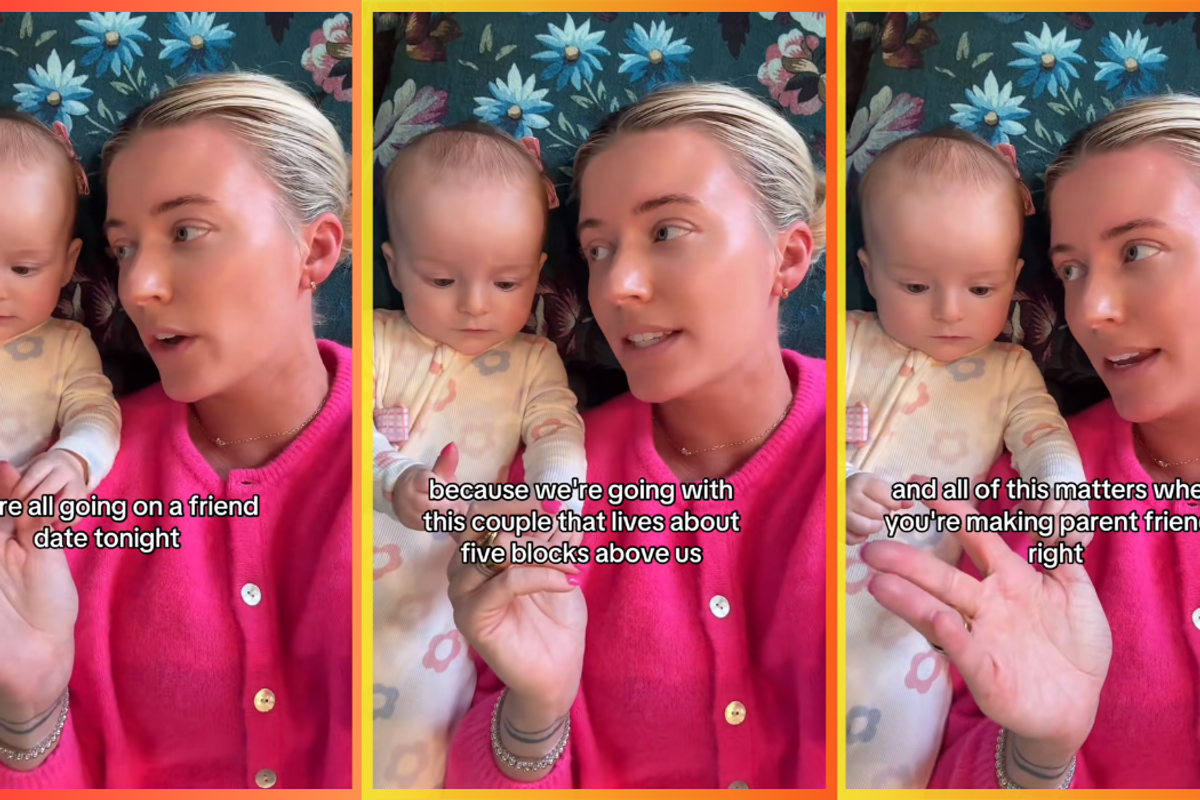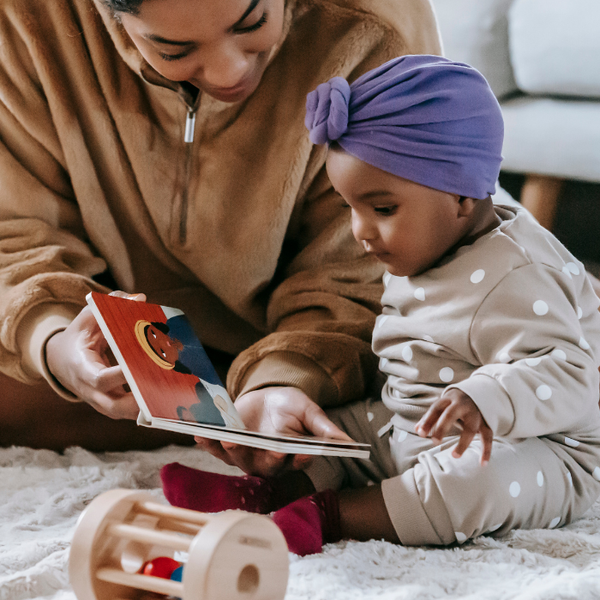Mom’s viral chats with 7-month-old could be the key to language development, science says
Who knew yapping could be so productive?

This could rewire her brain positively.
When Alex Bennett talks to her baby daughter Tate, she doesn’t use baby talk or silly voices. Instead, in her viral TikTok videos, she delivers high-speed, stream-of-consciousness monologues that would feel right at home in a scene from Gilmore Girls or The Marvelous Mrs. Maisel (pretty much anything written by Amy Sherman-Palladino, essentially). In a world used to spouting nonsense like “goo-goo” and “ga-ga” to babies, Alex’s approach is a refreshing reprise—and, according to scientists, might be a genius parenting move. Alex and her little one’s candid conversations aren’t just making the Internet swoon (Bennett's TikTok, @justalexbennett, has amassed 1.2 million followers, by the way). These chats could be rewiring baby Tate’s cognitive development for the better.

The beauty of babbling
Even though most parents instinctively use a high-pitched baby voice to talk to their infants, Bennett treats her sweet baby like a dear old friend. She yammers on about everything, from her thoughts on mommy-daughter matching outfits to the latest nanny drama.
And who could blame her? There’s so much to discuss: their plans for the night (watching hockey, followed by a new card game called Four Nations), the perfect surprise for dad’s birthday (bravely, they’ll be attempting a lava cake for the first time but they have a back-up plan just in case that fails: store-bought chocolate chip cupcakes), and the intricacies of making “parent friends” (as Alex explains, “All of this matters: 'Where do they live?' 'How old’s the baby?' Because if they had a baby that was two or three years old, they’d be able to walk and,” she pauses and looks at Tate, sweetly. “You’re not quite there yet.”). She even introduces her to the concept of “bedrotting” in one video, with the two of them snuggled up in their pajamas with zero plans to leave any time soon. No sing-song voice, no made-up or cutesy words. It’s as if they’re just two adult friends having a conversation, albeit Tate doesn’t speak much. But when she does manage to fit in a burble or two, her mom listens in rapt attention before responding accordingly.
“Her first word will be a paragraph!” commented one viewer. And according to science, she may not be far off.
Why this matters more than you think
While the videos are certainly cute (in one, Alex and Tate co-conspire—well, as much as a seven-month-old can—to convince dad to make them ground turkey bowls for dinner), according to research done by Kathy Hirsh-Pasek, a professor of psychology at Temple University and author of "Becoming Brilliant: What Science Tells Us About Raising Successful Children," there is an essential link between the amount of language children hear and their eventual language development. And the results don’t take long.
“Simply put, the more language children hear, the more words they produce.”
- YouTubewww.youtube.com
In a 2013 study called “Talking to children matters: Early language experience strengthens processing and builds vocabulary,” study authors Adriana Weisleder and Anne Fernald found that the more parents spoke to their children using “adult-style speech," the larger their vocabulary grew. By the time they reached two years old, these verbose children could already process words much better than their peers.
Yes, some of the comments on Alex’s videos are funny ( one user said, “So you’re telling me all I have to do is pop out a friend to talk to?”), but many others recognize the science at play here.
“This baby is going to be incredibly smart and articulate,” wrote another viewer, with another adding, “Jokes aside, this is actually the best way to stimulate proper language development in babies.”
How to set your kid up for success (by being a total motormouth)
Not all parents are convinced, though, that speaking to babies like mini-adults is such a good idea. "For one, they can’t speak back," a skeptic might sneer. Others roll their eyes and say something like “this feels weird and forced.”
The good news? There is no “right” way to speak to your newborns. But here are a few tips, just in case.
- Pay attention to their non-verbal reactions. The solution seems so simple, right? Just talk to your kids more. Speak nonstop, introduce more and more new words, and never, ever come up for air. Wrong. Just because they can't communicate through language, research suggests that children naturally pick up words and labels for things they find interesting. So, when it comes to introducing new words to babies, Harvard professor Catherine Snow, a pioneering researcher in the language and literacy field, recommends keeping an eye out for anything that might interest them: extra special gestures, excited noises, or facial expressions, and starting there. “Don’t wait for children to produce clear words before [you] start interpreting the noises that children make,” she warns. A toddler’s babbling isn’t something to scoff at: it’s their first attempt at communicating.
- Let them talk, too! As fun as it is to have a captive—and mostly silent—audience, there’s a subtle difference between talking at children and engaging with them. “If the adults just talk all the time, that doesn't work very well,” Snow adds. Interaction is key: notice what they’re interested in and comment on it. Label what they’re looking at. If they try to communicate, wait calmly and listen before responding. Alex has this down in spades. In a video, she begins to explain the family's plans for the night (they’re in Aspen at the moment), when suddenly, Tate begins to play with her mommy's face. Instead of correcting her or swatting her hands away, Alex just rolls with it, gleefully letting her daughter rub her tiny paws wherever she chooses, before asking her, laughing, “Do you like my red lips?”
- It’s all about context. The trick to teaching your toddler new words? Using them in the correct and natural context. For example, Snow paints a picture of a family gathering at the dinner table, where everyone is seated and alert. There are dozens of ways to demonstrate healthy language for the baby: A sibling might ask Mom about her day. If a car honks in the distance, someone could ask where the noise is coming from. 'Why are we eating chicken?' 'What is chicken?' 'Where does it come from?' The constant questions may seem tedious (especially when the people asking them likely know the answer), but Snow insists that these casual conversations are the foundations for babies to access new words and concepts.

Why this could change everything
Dr. Dana Suskind, founder and co-director of the Thirty Million Words Center for Early Learning + Public Health (and the co-writer of "Becoming Brilliant: What Science Tells Us About Raising Successful Children" with Kathy Hirsh-Pasek) has dedicated her research to encouraging parents to embrace their power as “brain architects.” As caretakers, everything—the words, sentences, ideas, and phrases a parent says (or withholds)—from their child can make a world of difference. Every word a baby hears, whether it’s about their new pajamas, the ribs and coleslaw being prepared for dinner tonight, or who will be at their next play date, all somehow seeps into their brain. They hear you, even though they can't quite understand you yet. These seemingly trivial conversations are literally the building blocks of language acquisition, and they are constructing your little one’s developing brain brick by brick, word by word.
So, remember: talking to your baby like an adult, with full-on sentences and lots of details, doesn't make you crazy: you’re building a stronger, smarter, and more loquacious future adult, one conversation at a time. They might even know what 'loquacious' means before preschool!
- Mom captures her 10-yr-old son on camera at 3am comforting her toddler so she could sleep ›
- A brave mother's video caught the attention of over 150 million Chinese citizens. ›
- Ramy Youssef perfectly walked the tightrope of religion, politics and humor in SNL monologue ›
- Mother's viral story of taking her baby to a job interview hits a nerve with moms everywhere ›

